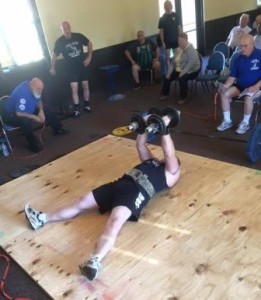Lateral Raise Lying
By Eric Todd

Eric Todd performed an All Time World Record of 60 kilograms at the 2016 IAWA Gold Cup.(photo and caption courtesy of webmaster)
This October past, I competed in the IAWA Gold Cup for the first time. This is kind of like the world championships of record breakers. When I decided to sign up for this meet, I wanted to choose a lift that I could go after not only just an age/weight class record, but an all-time record as well. I chose the lateral raise lying. The all-time record in this event was 55KG which equaled 121 in American pounds or 60.5 per hand dumbbells. It was held by Nick McKinless, who was an all-round world champ in 1996, Britain’s strongest man (under 105k) in 2006, as well as a Hollywood stunt man and an action director. I had heard of him plenty over the years, and figured beating a record of his would be something to sing about. Anyhow, I spent some time training for this lift. It took some playing about with it, but ultimately I hit 70 pounds per hand in training, and 66 per hand for 132 pounds or 60 kilo in the Gold Cup meet for the record.
The rules of this lift are as such:
Two evenly loaded dumbbells are used for this lift. The lifter lies on the platform, face up. The dumbbells are placed on the platform on both sides of the lifter, who grips the dumbbells with the palms of the hands facing up at arms’ length, with the arms at a 90 degree angle to the body. Legs are to be straight and flat to the platform, and must remain that way throughout the lift. Width of legs spacing is optional, but must remain in that position throughout the lift. Maximum diameter of the dumbbell plates is 11 inches. The arms must remain straight and elbows locked during the lift. The arms must maintain a 90 degree angle to the body during the lift. Once the lifter is in the correct starting position on the platform, an official will give a command to start the lift. The lifter then raises the dumbbells to a position over the lifter’s body until the dumbbells touch. The dumbbells must be lifted simultaneously. Once the dumbbells are motionless, an official will give a command to end the lift.
Anyhow, I thought I would give some pointers here on things I found technique wise to help out on this lift. The first thing I did was spread my feet apart to give myself a wide base for stability. As long as they stayed there, it was within the confines for the rules. Then I pulled my lats in tight, pulling my shoulder blades together. This shortened the length of my levers giving me much better leverage. I tightened my core, and squeezed my glutes. I then lifted my head and began the lift. On the way up, I really focused on keeping my elbows straight. Did not matter if I completed the lift, if my elbows bent it would have been a no lift. I also focused on just keeping the weight moving. It did not matter how slow the lift, if it ended up together at the end. If I had it to do over again, I would train strictly with standard dumbbells. I used standard dumbbells up to 50s in training, but then loaded up Olympic dumbbells. After that with 25s. They fell within the 11” diameter, but the 10 kilo plates at the meet were a bit bigger, so we had to go with 5s, which were smaller than what I was used to. If I had accustomed myself to the longer pull, that would not have been an issue.
I know it is not the most contested lift in the USAWA/IAWA, but it was a fun lift to train. Maybe you can use some of these pointers to put up your own records in this lift.